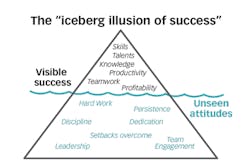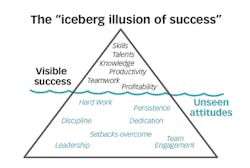The iceberg illusion of implementing new technology: What to ask yourself
Gary Kaye, DDS, FAGD
These days, NEW AND INNOVATIVE TECHNOLOGIES are being introduced into the profession on what feels like a daily basis. Deciding when they have evolved enough for them to be useful and worth the investment, however, presents a unique and challenging problem.
The lure of new technology can be difficult to resist. As professionals, we always want to be on the cutting edge of innovations and trends. We want our offices to be outfitted with the latest high-profile machines and software, whether to deliver the most up-to-date care for our patients or to streamline the clerical functions of our businesses. We peruse the latest magazines, talk to company representatives, and juggle cost-to-benefit ratios.
The difficult part is determining whether the "want" also carries with it a "need." The desire to invest in new technologies may be the right choice for your practice, especially if those advancements deliver benefits. On the other hand, it is not unreasonable to maintain a system that works well and that your staff is comfortable with.
My own practice had an experience with the "want vs. need" issue. For years, we had used a popular accounting software program. The vendor touted the new cloud-based version, allowing instant access to accountants, bookkeepers, office managers, and owners. It seemed superior and new. After the trying conversion process, we discovered that the former system was far more stable. The new version relied too heavily on waxing and waning internet connections. In our attempt to chase upgrades, we temporarily lost productivity and brought unnecessary stress because we "wanted" what we did not "need." We converted back to the original desktop version and have been using it ever since.
Determining whether the transition to new technology is worth the potential disruption is essential. Two nearly identical practices may have entirely different results based on the technological competence of their staff. Staff members who adapt quickly to new technologies may work well with innovation. Others may require advanced notice, hands-on training, or even outside education. The stress of the new advancements should always be considered alongside other aspects of investing in new innovations.
Should the "need" justify the "want," cutting-edge technology can help bring modern practices to the forefront of dental excellence. Digital dentistry, which offers countless advantages such as manufacturing chairside CAD/CAM restorations and obtaining 3D images of hard and soft tissues, is one such advancement. Without question, its applications can benefit the practice, the patients, and the skills of any dental professionals trained in its use. However, the "need" of the practice must come first. The advancement of an office's technology should be tailored toward every conceivable aspect of that individual environment.
Get it right
When determining what technology is right for your practice, the key is to look at what exactly you're trying to achieve and how you can achieve those goals with the technology. We have found that in order to be successful with implementing new technology, there is a lot more to the "how" than the "what." For example, see the "iceberg illusion of success" illustration. Although the task may seem straightforward, what you see is only the beginning-and you ignore what lies underneath at your own risk.
Implementing technology, like anything we do in our lives and practices, requires a lot more than just the vision of success. The success comes after all the work, dedication, discipline, persistence, and setbacks overcome. Understanding what one needs to do to be successful plays a role in the decision. It is incumbent on the practice owner to create the right attitude around the new technology. Skills and knowledge about the technology are key success factors, but attitude plays a far bigger role. Engaging your entire team will strengthen your plan and help navigate through the risks that can undermine your success.
Lastly, we have found that using checklists (see nycdd-resources.org/3ir-introduction) can be very helpful in systematic planning, monitoring progress, and keeping the adoption on track to success.
Gary Kaye, DDS, FAGD, founder of the New York Center for Digital Dentistry, has practiced comprehensive dentistry in New York City since 1993. He graduated from Columbia University of Dental Medicine in 1993, where he received awards in endodontics, prosthodontics, and geriatric dentistry. Dr. Kaye consults with other dentists and dental manufacturers and lectures on topics including ceramics, occlusion, and digital dentistry. He is on the guest faculty of Planmeca University in Dallas, Texas.

